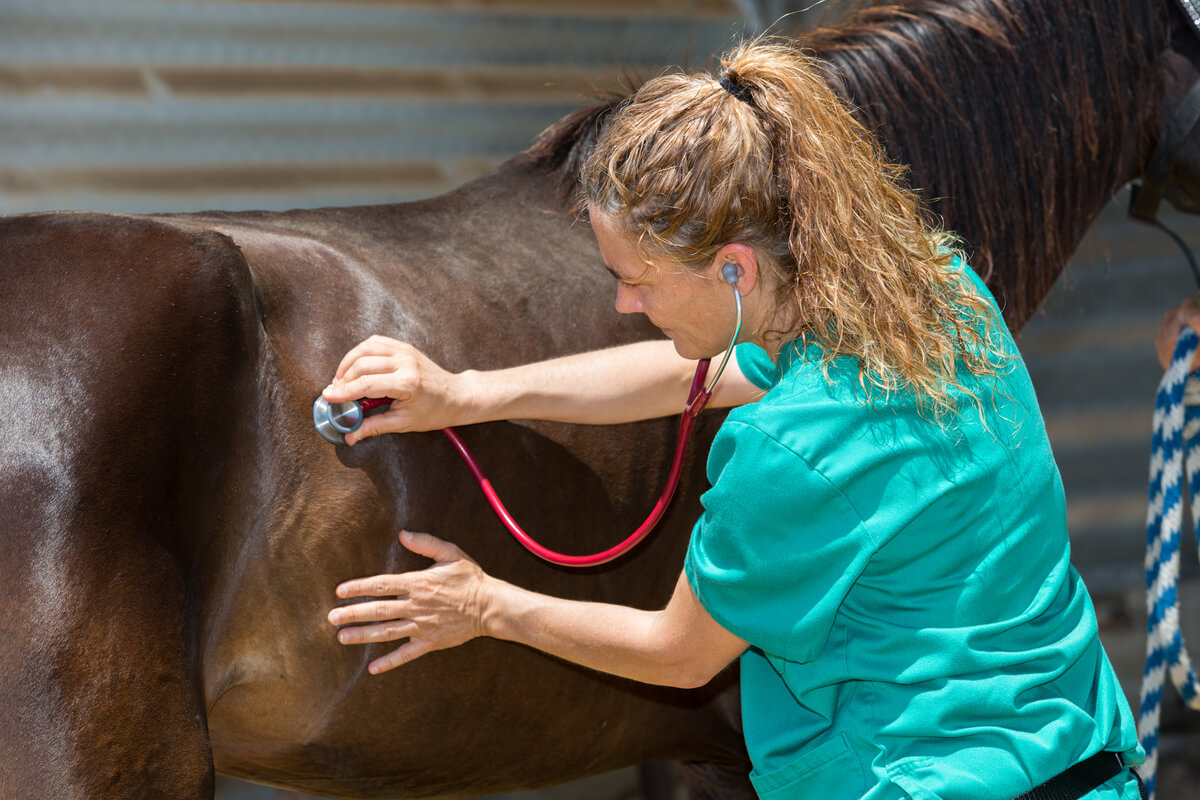Metabolic Disorders in Horses


Reviewed and approved by the biologist Samuel Sanchez
Any biochemical process can be altered by different causes in a horse’s body, which gives way to the famous metabolic disorders in horses. These can have different severity, but all must be detected and treated as soon as they’re diagnosed.
On seeing any relevant symptom, the horse’s owner needs to act quickly. However, there are also diagnostic tests that can be used to predict the possibility of a disease, and prevent it or prepare treatment. Read on if you want to know more about these disorders.
What are metabolic disorders?
Before explaining what metabolic disorders are, it’s important to clarify what metabolism is. Metabolism refers to all the processes that take place in a body that break down and transform ingested substances into the energy and nutrients that are essential for life.
Many foods are complex materials that undergo metabolic processes to break down into simpler substances. In turn, these will be converted into what the body needs to maintain itself. One example is proteins, which are broken down into amino acids. The body uses these molecules to create new proteins and important metabolic reactions.

A metabolic disorder is said to be present when abnormal chemical reactions occur in the body that disrupt these processes. If this happens, the horse’s body may have an excess or deficit of certain substances that it needs to stay healthy.
Metabolic disorders can be inherited or acquired. It’s important to detect metabolic disorders in horses, as they’ll affect their vitality and their body. In addition, they may complicate other conditions and make it difficult to heal injuries.
Metabolic storage disorders in horses
When a metabolic disorder causes a substance to rise to levels toxic to the body within the cells, due to the body’s inability to break it down, it is called a storage disorder. This occurs because there is a total or partial lack of a certain enzyme (which is what would have prevented the substance from accumulating to a toxic level).
Metabolic storage diseases usually spread throughout the body of the animal, although most of the symptoms end up being reflected in the central nervous system. There are two types of metabolic storage disorders: genetic and acquired. These are discussed in detail below.
Genetic disorder
Genetic disorders are inherited from the parents. These pathologies are named depending on the specific metabolic by-product that accumulates in the body of the sufferer.
These are progressive pathologies that usually end in death, as there’s no specific treatment to resolve them. According to experts, there’s no confirmed data showing evidence of metabolic diseases in horses due to genetic storage.
Acquired disorders
Acquired metabolic disorders also affect horses. One of the main reasons for this pathology is the consumption of certain plants that have specific enzyme inhibitors.
For example, eating henbane (Hyoscyamus niger) for a prolonged period of time can lead to an acquired neurological storage disease. It has toxic effects, which horses are very susceptible to.
Metabolic disorders in horses related to production
Unlike storage diseases, some metabolic disorders in horses are caused by a high demand for a nutrient that is at a low level in their body.
An example is hypocalcemia in horses, which means that the blood calcium level is too low. Another case would be hypoglycemia, where the equine’s metabolic reserves aren’t able to maintain blood sugar (glucose) at an optimal level for normal function.
Equine Metabolic Syndrome (EMS): what is it?
Equine Metabolic Syndrome (EMS) is a disease that develops in the horse’s metabolism, and which is closely related to obesity and insulin resistance.
There are certain breeds of horses that are more predisposed to suffer from equine metabolic syndrome, as is the case of the purebred Arabian or Spanish thoroughbred. However, all horses considered to be easy keepers tend to experience this disease.
The so-called easy keeper horses are known as “easy feeders”. They’re animals that seem to gain weight whatever they eat, even if they’re simply feeding from the pasture and not on feed.
Unlike equines that are obese because they’ve been overfed, easy keepers don’t need a diet to lose weight at a normal rate. They have a much harder time reducing their pounds and gain them more quickly than the average horse.
Obesity and fatty deposits
A horse that suffers from obesity is more prone to equine metabolic syndrome. However, any horse that appears healthy on the surface (except for having fatty deposits in certain areas of its body) is also at risk.
These fatty deposits usually occur in places such as the base of the tail, the back, the ridge of the neck, and the shoulders. The guardians of horses that have these fatty deposits define them as love handles.
Equine Metabolic Syndrome treatment
Equine Metabolic Syndrome can be treated by following certain guidelines. We’ll show them below.
The diet
The main measure will be to establish a diet that reduces energy and soluble carbohydrate administration. When excess weight has been the cause of the disease, there are two possibilities:
- Provide the equine with quality forage in combination with a supplement that balances mineral and vitamin levels.
- Provide quality forage in combination with a very low starch feed (and adequate amounts of sugar).
Exercise
The diet has to be accompanied by progressive exercise for best results. This physical activity should be done moderately and regularly (rather than intensely in a few sessions).
Medical treatment
The veterinary professional can prescribe medication when diet and exercise aren’t enough. This will be modified as the horse slimming and always under strict veterinary guidelines.
When it comes to metabolic disorders in horses, we must be very aware of the symptoms, because they shouldn’t be confused with other health problems in this animal. Because they’re so diffuse, they’re sometimes difficult to distinguish from other clinical entities.
For example, the difference between a metabolic production disorder and a nutritional deficiency is subtle. However, while both conditions often have serious consequences for the equine, the metabolic disorder can appear suddenly and requires a quicker and more accurate diagnosis.
The speed of diagnosis can be the difference between saving the life of the animal or not.

As you’ve seen, there are many types of metabolic disorders in horses and some are more lethal than others. Don’t hesitate to go to the vet with your horse if you notice any of the above symptoms.
All cited sources were thoroughly reviewed by our team to ensure their quality, reliability, currency, and validity. The bibliography of this article was considered reliable and of academic or scientific accuracy.
- Introduction to Metabolic Disorders of Horses. Recogido el 30 de septiembre en https://www.msdvetmanual.com/horse-owners/metabolic-disorders-of-horses/introduction-to-metabolic-disorders-of-horses
- Síndrome metabólico y resistencia a la insulina en el caballo. Recogido el 30 de septiembre en https://es.laboklin.info/wp-content/uploads/2016-11-aktuell.pdf
- What is equine metabolic syndrome? Recogido el 30 de septiembre en https://ceh.vetmed.ucdavis.edu/health-topics/equine-metabolic-syndrome
- Metabolic disorders in the modern horses. Recogido el 30 de septiembre en https://hygain.com.au/blogs/library/calming-feeds-competition-horses
This text is provided for informational purposes only and does not replace consultation with a professional. If in doubt, consult your specialist.